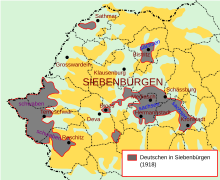Transylvanian Saxon dialect
This article includes a list of general references, but it remains largely unverified because it lacks sufficient corresponding inline citations. (May 2016) |
| Transylvanian Saxon | |
|---|---|
| Siweberjesch Såksesch | |
| Native to | Romania, Germany, Austria |
| Region | Transylvania (German: Siebenbürgen) |
Native speakers | c. 200,000 |
Indo-European
| |
| Language codes | |
| ISO 639-3 | – |
| Glottolog | tran1294 |
 Areas where Transylvanian Saxon was spoken in 1918 (but with Swabian in the west). | |
Transylvanian Saxon (Saxon: Siweberjesch-Såksesch or just Såksesch, German: Siebenbürgisch-Sächsisch or siebenbürgisch-sächsische Sprache, Hungarian: Erdélyi szász nyelv, Romanian: Limba săsească or dialectul săsesc) is the German dialect of the Transylvanian Saxons.
In terms of comparative linguistics, it pertains to the Moselle Franconian group of West Central German dialects. In this particular respect, it must be stressed that it shares a consistent amount of lexical similarities with Luxembourgish.
The dialect was mainly spoken in Transylvania (contemporary central Romania), by individuals of German, Flemish, and Walloon origins who were settled in the Kingdom of Hungary starting in the 12th century.
In the contemporary era, the vast majority of the native speakers have emigrated in several waves, initially to Germany and Austria, but then subsequently to the USA, Canada as well as other Western European countries, managing in the process to preserve (at least temporarily) their specific language there.
Before the Romanian Revolution of 1989, most of the Transylvanian Saxons were still living in Transylvania. During the communist dictatorship of Nicolae Ceaușescu, many thousands of these Saxons were sold per capita[specify] for a huge amount of money paid to socialist Romania by West Germany.
By 1990, the number of Saxons living in Transylvania had decreased dramatically. Shortly after the fall of Communism, from 1991 to 1994, many Transylvanian Saxons who still remained in Transylvania decided to ultimately emigrate to Germany, leaving just a minority of about 15,000 to 16,000 Transylvanian Saxons in Romania.
The number of native Transylvanian Saxon speakers today is estimated at approximately 200,000 persons. Transylvanian Saxon is also the native dialect of the current President of Romania, Klaus Iohannis.
Alphabet[]
- A - a
- B - be
- C - ce
- D - de
- E - e
- F - ef
- G - ge
- H - ha
- I - i
- J - jot
- K - ka
- L - el
- M - em
- N - en
- O - o
- P - pe
- Q - ku
- R - er
- S - es
- T - te
- U - u
- V - vau
- W - we
- X - ix
- Y - ipsilon
- Z - zet[1]
Orthography and pronunciation[]
Vowels[]
- a - [a/aː]
- au - [aʊ̯]
- å - [ɔː]
- ä - [ɛ/ɛː]
- äi - [eɪ̯]
- e - [ɛ~e~ə/eː]
- ei - [aɪ̯]
- ë - [e]
- i - [ɪ/iː]
- ië - [i]
- o - [ɔ/oː]
- u - [ʊ/uː]
- uë - [u]
- ü/y - [ʏ/yː][2]
Consonants[]
- b - [b~p]
- c - [k~g̊]
- ch - [x~ʃ]
- ck - [k]
- d - [d~t]
- dsch - [d͡ʒ]
- f - [f]
- g - [g~k~ʃ]
- h - [h~ː]
- j - [j]
- k - [k~g̊]
- l - [l]
- m - [m]
- n - [n]
- ng - [ŋ]
- nj - [ɲ]
- p - [p~b̥]
- pf - [p͡f]
- qv - [kv]
- r - [r~∅]
- s - [s~ʃ~z]
- sch - [ʃ]
- ss - [s]
- t - [t~d̥]
- tsch - [t͡ʃ]
- v - [f/v]
- w - [v]
- x - [ks]
- z - [t͡s][3]
Bibliography[]
- Siebenbürgisch-Sächsisches Wörterbuch. A. Schullerus, B. Capesius, A. Tudt, S. Haldenwang et al. (in German)
- Band 1, Buchstabe A – C, 1925, de Gruyter, ASIN: B0000BUORT
- Band 2, Buchstabe D – F, 1926, de Gruyter, ASIN: B0000BUORU
- Band 3, Buchstabe G, 1971, de Gruyter, ASIN: B0000BUORV
- Band 4, Buchstabe H – J, 1972
- Band 5, Buchstabe K, 1975
- Band 6, Buchstabe L, 1997, Böhlau Verlag, ISBN 978-3-412-03286-9
- Band 7: Buchstabe M, 1998, Böhlau Verlag, ISBN 978-3-412-09098-2
- Band 8, Buchstabe N - P, 2002, Böhlau Verlag, ISBN 978-3-412-12801-2
- Band 9: Buchstabe Q - R, 2007, Böhlau Verlag, ISBN 978-3-412-06906-3
References[]
- ^ "Transylvanian Saxon". Omniglot. Retrieved 8 February 2021.
- ^ "Transylvanian Saxon language". Omniglot. Retrieved 8 February 2021.
- ^ "Transylvanian Saxon language". Omniglot. Retrieved 8 February 2021.
External links[]
- SibiWeb: Die Sprache des siebenbürgisch-sächsischen Volkes von Adolf Schullerus (German)
- Verband der Siebenbürgersachsen in Deutschland: Sprachaufnahmen in siebenbürgisch-sächsischer Mundart - Audiosamples (German, Såksesch)
- Siebenbürgersachsen Baden-Württemberg: Die Mundart der Siebenbürger Sachsen von Waltraut Schuller (German)
- Hörprobe in Siebenbürgersächsisch (Mundart von Honigberg - Hărman) und Vergleich mit anderen Germanischen Sprachen (German)
- Transylvanian-Saxon people
- Central German languages
- German dialects
- Languages of Romania
- Languages of Hungary

